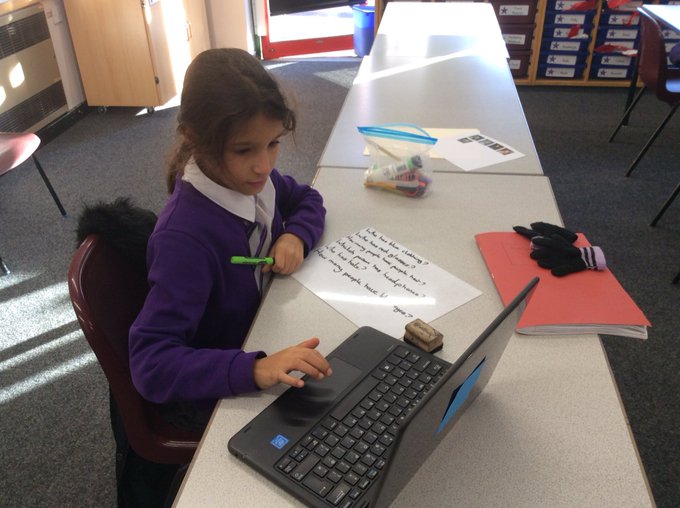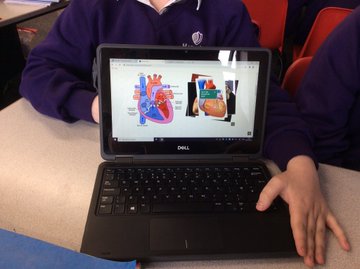Computing

Overview:
At Hazel Leys, we know that technology is an integral part of everyday life, with new careers in technology ever evolving. We want to prepare our children for a future which is shaped by technology. It is important that we model and educate out children on how to use technology safely, positively and responsibly. We aim for our pupils to be creators, rather than consumers of technology and our curriculum focused on computer science, information technology and digital literacy to reflect this.
We want our pupils to understand the many choices that come with technology and to understand the lasting imprint their digital footprint leaves. Our computing curriculums aims to engage children in all the different ways that technology can be used positively, moving away from a social media culture. At Hazel Leys, we want the children to become confident with a range of tools to best express their understanding of technology and to feel comfortable using these tools independently as they prepare for key stage 3.
The curriculum fulfils the requirements of the National Curriculum for England. This course of study seeks to show how technology shapes the world around us. The curriculum is split into 6 areas of learning. It is designed so that each year group will complete a unit of work in these different areas once a year. The curriculum is designed on a spiral approach meaning that the themes are constantly revisited so that learning can be consolidated and then built upon.
 Intent:
Intent:
Each unit specifies the concepts and skills which the students are expected to learn over the course of a unit. These concepts and skills progress gradually throughout the course of the six years of study. At Hazel Leys, our computing curriculum is the “Teach Computing” scheme. The intent of the curriculum is for all learning outcomes to encapsulate the disciples of computing:
- Algorithms
- Computing networks
- Computing systems
- Creating media
- Data and information
- Design and development
- Effective use of tools
- Impact of technology
- Programming
- Safety and security
The “Teach Computing” scheme is designed to support all pupils, with lessons being sequenced so that it builds on the learning from the previous lesson. Activities are scaffolded so that all pupils can succeed and thrive. Options for deepening understanding are available in all lessons.
 Implementation:
Implementation:
At Hazel Leys, the sequence of lessons follows a structure to enable the students to become familiar with, understand and practise using technology. Planning for each unit of work specifies the discipline/skills the children will work on. Throughout the course of the lessons, the students explore how to use technology to create content safely, positively and responsibly. All staff know that modelling is an important part of the teaching process, as such, lessons are structured in order to support the children to use technology independently.
The students’ understanding of key skills and concepts builds from year to year, assessing and cementing prior learning, and therefore the implementation of the curriculum in the given sequence is crucial. Built within the “Teach Computing” scheme is the “Education for a Connect World” framework, which aims to support and broaden the provision of online safety education. We believe that high quality online safety must be taught if children are to keep themselves safe in the virtual world. It is therefore essential, to ensure pupils are equipped with the skills to recognise risks online, to be critically aware of the materials and content they access online, along with guidance on how to accurately validate information accessed via the internet. In addition to this provision, the whole school participates in 'Safer Internet Day' in February to reinforce the importance of using technology responsibly.
Alongside our curriculum, staff make connections with local STEM hubs to ensure that the children have access to up-to-date technology. STEM ambassadors are invited to school to talk to the children about careers in technology and to apply their learning to the wider world. Computing is taught every week from years 1-6, with opportunities to use technology in other curriculum areas.
EYFS
The children in the Early Years will have daily opportunities to use technology. Technology is incorporated into daily lessons, so that the children can see the far reaching uses that technology can have, but also so that staff can model how to use it responsibly and positively. The aims of technology in the Early Years is to familiarise pupils with technology that will use more formally in Key Stage 1. Children will have access to iPads, interactive whiteboards, laptops, keyboards, bee-bots, cameras, and other recording devices. Staff will use role play opportunities for children to act how they can use technology.
Digital literacy is a fundamental skill for all and this starts in the Early Years. By introducing computing to our youngest pupils, it will help them get to grips with technology, preparing them for a world where digital skills are essential. E-safety is also delivered to the children in EYFS to support them form healthy relationships with technology.
Every unit of work covers all of the Early Learning Goals (ELG’s) within the Early Years Framework.
 Impact:
Impact:
The impact of this curriculum design will lead to progress across key stages relative to a child’s individual starting point and their progression of skills. Our Computing curriculum will also lead pupils to be enthusiastic learners, evidenced in a range of ways, including pupil voice, work scrutiny and confidence when using technology. We ensure that children who are achieving well, as well as those who need additional support, are identified, and additional provision and strategies are planned in and discussed with class teachers.
We will measure the impact of our curriculum through the following methods:
- Annual reporting of standards across the curriculum.
- A reflection on standards achieved against the planned outcomes;
- A celebration of learning for each term which demonstrates progression across the school;
- Pupil discussions about their learning; which includes discussion of their thoughts, ideas, and evaluations of work.
Pupils should leave school equipped with a range of skills to enable them to succeed in their secondary education and be innovative and resourceful members of society. We will be able to evaluate the impact of our Computing curriculum through recording the children’s voice and monitoring the work that they produce.
We expect that children will able to demonstrate:
- Confidence when using technology.
- An understanding of algorithms.
- An understanding of how computer networks can be used to retrieve and share information.
- An understanding of what a computer is and how its constituent parts function together as a whole.
- How to select and create a range of media.
- How data is stored, organised and used to represent real world artifacts and scenarios.
- An understanding of activities involved in planning, creating and evaluating computing artifacts.
- How to use software tools to support computing work.
- An understanding of individuals, systems and society as a whole interacts with computer systems.
- How to use software to allow computers to solve problems.
- An understanding of risks when using technology and how to protect individuals and systems.


